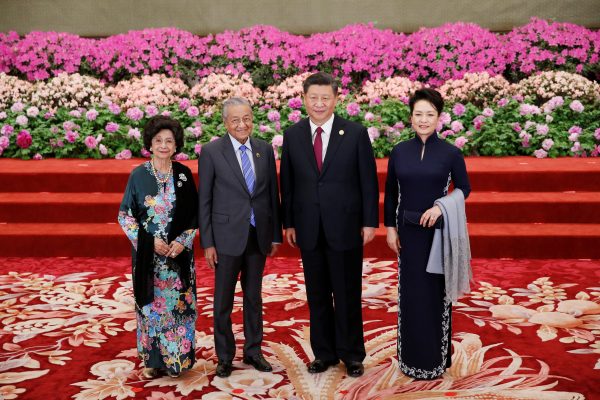Thirty-seven heads of state, government representatives and representatives of international organisations gathered in Beijing for April’s BRF. Deals collectively worth US$64 billion were signed during the three-day summit. Leaders also issued a joint communique expressing their shared commitment to advancing high-quality, sustainable and inclusive Belt and Road cooperation.
Five years since its inception in 2013, the BRI has established itself as a defining feature of the global economy and politics. BRI-induced Chinese outbound direct investment totals US$80 billion. More than 80 special economic zones and high-tech industrial parks have either been built or are under construction, creating jobs and billions in extra tax revenue for host governments. Trade between China and BRI partners is flourishing at a time when global trade faces uncertainties. Between 2013 and 2016, the value of China’s merchandise trade with BRI countries increased at a faster rate than China’s overall foreign trade.
An important contributor to the rapid growth in trade is enhanced transport connectivity. In the past, direct rail services between China and Europe were inconceivable. But thanks to the BRI, Duisburg, a lesser-known city in Germany, has become the largest inland port in the world. Shipping goods from Chongqing to Duisburg takes 45 days by sea but only about 12 days by rail. In 2018, 6300 containerised freight trains from China used this route. That figure could rise to 10,000 within five years.
China and BRI countries have launched more than 1200 new international air routes and signed 18 transport facilitation agreements to improve the efficiency of commercial border-crossing. New trade routes are also being created.
Simultaneously though, a number of non-BRI countries have criticised the BRI. The United States sees the BRI as a cover for ‘debt-trap diplomacy’ through which China lures borrowing countries into unrepayable debts to gain political leverage over them.
The BRI is at risk of losing its lustre among several once enthusiastic participants due to a host of practical implementation problems. In the wake of the Hambantota Port handover, Sri Lanka appears disillusioned, having chosen to stay away from this year’s BRF. Several countries like Pakistan, Malaysia, Myanmar, the Maldives and Bangladesh have sought to review, re-negotiate, cancel or scale-down BRI commitments, citing concerns over cost overrun, erosion of sovereignty and reports of corruption. Malaysia’s East Coast Rail Link is back on track, but only after China reduced the price tag by about a third.
At the BRF, Chinese President Xi Jinping acknowledged the criticisms levelled against his signature policy and pledged to reform it in a number of ways. First, China will ‘multilateralise’ the BRI. Xi declared strong support for multilateralism and vowed to work more closely with multilateral development banks in third markets. He also attached importance to the BRI adopting multilateral rules and international best practices pertaining to project development, operation, procurement, and tendering and bidding.
With the help of Singapore, China is establishing a panel of international mediators from BRI countries to resolve disputes, including cross-border disputes, arising from projects under the BRI. China has also listed ‘Strengthening Development Policy Synergy’ with similar initiatives, such as ASEAN Connectivity 2025 and the EU Strategy on Connecting Europe and Asia, as the top priority for jointly developing the BRI.
Second, China will make the BRI more sustainable. A BRI Debt Sustainability Framework, similar to those of the International Monetary Fund and World Bank, was released to help partner countries in decision-making. Responding to environmental concerns, Xi made a pledge to ‘launch green infrastructure projects, make green investment and provide green financing’. On the socio-political front, the BRF endorsed the ‘Beijing Initiative for the Clean Silk Road’, pushing BRI countries into fighting corruption together. This step is path-breaking as previous BRI policy statements rarely referenced anti-corruption.
Third, China will continue structural reforms including beefing up the enforcement of intellectual property rights, stopping involuntary technology transfer, and abolishing unreasonable regulations, subsidies and practices. A successful BRI cannot be a one-way street where BRI partner countries open up to Chinese trade and investment while China shuts its doors on them. Stakeholder countries have also been requested to create an investment-friendly environment and to treat Chinese enterprises in a fair and friendly manner.
In light of pushbacks and criticisms during the BRI’s first five years, China has pledged reform. This could lead to the emergence of a BRI 2.0. If China implements these reforms effectively and cooperation with development partners and stakeholder countries increases, this new BRI 2.0 will be better positioned to lead to shared prosperity for all participants.
Dr Pradumna B. Rana is Associate Professor and Coordinator of the International Political Economy Programme at the Centre for Multilateralism Studies in the S. Rajaratnam School of International Studies (RSIS), Nanyang Technological University (NTU), Singapore.
Dr Xianbai Ji is a Research Fellow at the S. Rajaratnam School of International Studies (RSIS), Nanyang Technological University (NTU), Singapore.
A version of this article was originally published here on RSIS.

